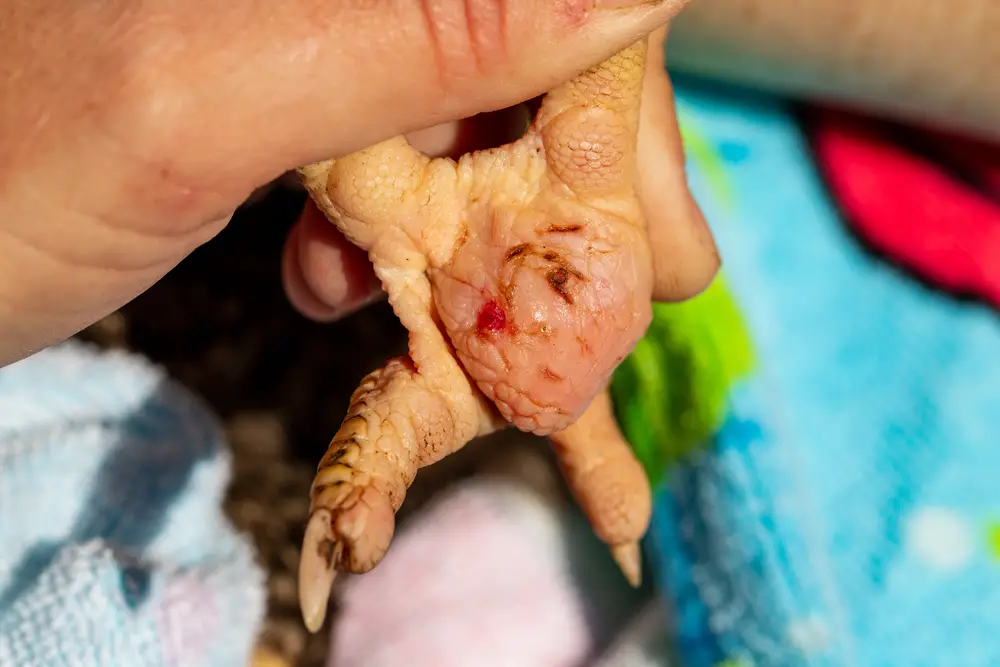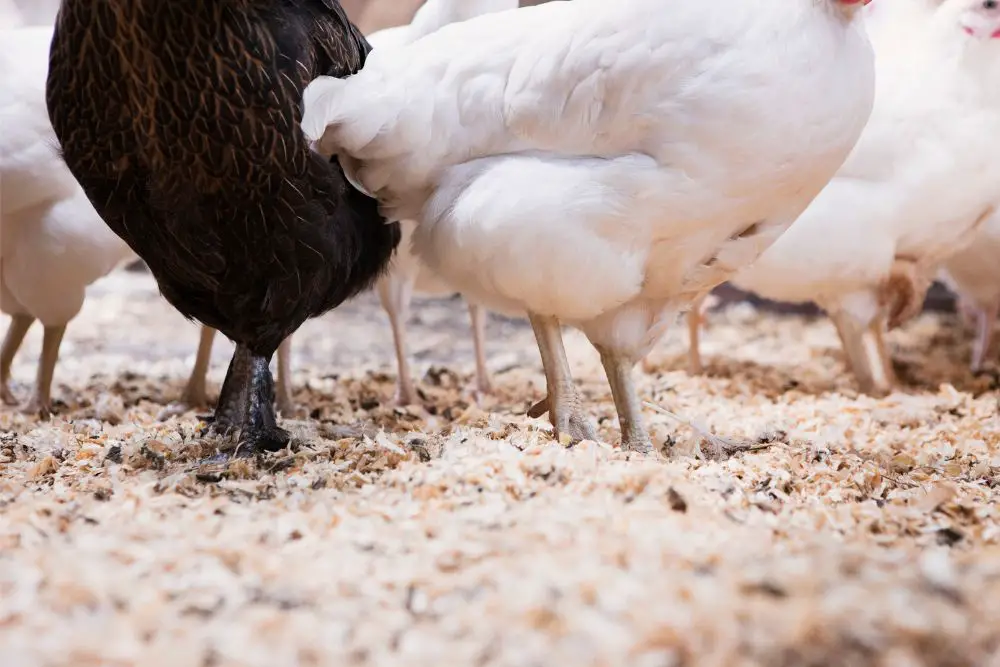If you’ve noticed that your backyard chicken has started limping, there are several conditions that could be causing internal or external foot problems. Fortunately, once the condition is identified, many of these foot problems have treatment options available.
This article discusses the most common foot problems that chickens face and what is the best method of treating them. Even though foot injuries can seem scary at first, many chickens do recover after several weeks.
Table of Contents
What Creates Foot Problems In Chickens?
Each leg ailment or foot problem is caused by its own set of circumstances. There are some general behaviors and traits that can make a chicken more susceptible to certain injuries or conditions. Most of these causes are directly correlated with how the chicken is being cared for and the state of their health overall.
For example, issues such as scaly leg mite and convict’s foot occur in conditions where the chicken coop or brooder aren’t being properly cleaned and maintained. In the case of leg mites, they are drawn to and reproduce in damp and dirty areas.
Convict’s foot is when mud or poop collects on the toenails of the chicken, making it difficult for them to properly walk. It is important in these scenarios to reevaluate your cleaning schedule and methods in order to prevent these issues from occurring in the future.
Other foot problems can be caused by behavioral issues or simply by accidents. Foot injuries can happen accidentally if you mishandle a bird by picking one up by its feet or by accidentally dropping them. Other times your rooster might grow aggressive and end up hurting another one of your birds physically in a fight.
It’s often best to accept that facing these problems is a natural part of raising chickens. Much like humans, chickens often get sick and injured. These are challenges that all chicken keepers must overcome. Being prepared to face these road bumps will help you overcome them more quickly.
Now let’s take a closer look at a few of the more common foot problems that you and your flock might have to face.
Bumblefoot
Bumblefoot, otherwise known as Pododermatitis, is an infection in the pad of a chicken’s foot. They are easily identified by a large, black scab at the bottom of the foot that will cover an abscess filled with pus.
This condition is usually rather painful for a chicken. They will likely be seen limping and putting as little weight as possible on the infected foot. The infection usually starts when a foreign object cuts or punctures the bottom of the chicken’s foot pad, such as a splinter or a sharp bit of chicken wire.

If your chickens are known to jump down from high roosts or perches, they risk heavy landings that could lead to such injuries. Once the foot has an open wound, it is usually exposed to the bacteria, staphylococcus, in chicken droppings when foraging or scratching at the ground in areas that haven’t been properly cleaned.
If left untreated, the infection of bumblefoot will almost certainly lead to total lameness and could become fatal in severe cases if the infection spreads.
Leg Mites and Scaly Legs
Scaly legs is a condition caused by mites that crawl underneath the scales on a chicken’s legs and feet. This condition is most known to affect older birds, but can also be passed onto younger members of the flock.

As the mites burrow into the cracks between the scales, the scales will noticeably lift up from the skin. The legs will appear to be raised and bumpy, and there’s usually a noticeable white crusty layer surrounding each individual scale.
The longer the mites are present, the more damage they will do to the chicken’s legs. Mites can cause serious deformities and lameness, and eventually lead to the loss of toes as well.
Leg Injury
Sprains, lesions and broken bones are some of the most common leg injuries that your chickens will face. Chicken feet and legs are incredibly exposed, as they are usually unfeathered and only covered by a thin layer of scales.
As mentioned previously, these injuries are likely caused by either accidentally mishandling the bird or through the bird’s own actions. Always be careful to not pick a chicken up by the legs or by dropping them from too high of a height. Chickens, especially bantam or small varieties, can be very fragile, so even small cases of mishandling can lead to sprains or broken bones.

If one of your chickens has grown aggressive, be sure to keep an eye on them and isolate them as needed. Whether it be a rooster in mating or an overly broody hen, make sure that the rest of the flock is safe from their actions.
Sometimes a predator, such as the fisher cat, will attack your coop and leave several members of your flock injured. In the case that multiple chickens in your flock are injured at the same time, then it is usually okay to have them all isolated together away from your other chickens.
Frostbite
Chickens are known to be a cold hardy species, but that doesn’t mean they are totally immune to frostbite. Frostbitten feet will usually be dark blue or black in color, and your chicken will likely limit the amount of weight that they put on that particular foot.
Frostbite is usually caused by chickens spending too much time on cold snow or ice. It is best to keep your coop and run completely cleared of snow for this very reason, so keep a snow shovel on hand throughout the winter months.
Treatment Options
Having identified some of the common foot problems with chickens, let’s now understand how to treat these conditions.
Bumblefoot
In order to fully treat bumblefoot, the infected area usually needs to be cut open with a surgical scalpel and cleared of abscess pus, kernel of dead tissue, and any other foreign objects with tweezers. This process of bumblefoot treatment is pretty involved and quite graphic, so if you don’t feel confident in performing the surgery yourself, then you may want to bring your chicken to the vet.
Once the operation is completed, you’ll want to constantly clean the healing wound with a peroxide vet wound cleaner such as Vetericyn VF and replace the bandages every other day for about a week.
Leg Mites and Scaly Legs
Leg Mites can be tricky to get rid of, as they are usually persistent in living underneath the scales on the legs. Most treatment options involve soaking the affected areas in a solution of linseed oil, vaseline and sulfur which are used to suffocate and kill off any mites that are present. In more severe cases, the medication Ivermectin can be prescribed by a veterinarian to help remove leg mites.
Leg Injuries
Most minor leg injuries will heal on their own if kept properly cleaned, and you’ll want to make sure any chickens with a sprain or broken leg keep their weight off of it until it fully heals.
Make sure to properly dress any open wounds in order to prevent bacterial infection. It’s usually best to keep them in a smaller pen until they are fully healed before reintroducing them to the rest of the flock.
Frostbite
Many chickens are able to naturally recover from frostbite. Make sure to bring your bird inside where it is warm and soak the frostbitten feet in a bath of warm water with epsom salts. Dry them completely before applying Neosporin to any open blisters and wrapping a gauze pad with vet wrap.

